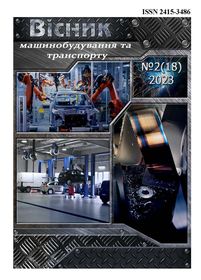Safety study of a roundabout
DOI:
https://doi.org/10.31649/2413-4503-2023-18-2-175-182Keywords:
roundabout, traffic flow, intensity, safety, geometric design.Abstract
Roads ensure continuous, safe and convenient movement of vehicles. Intersections play a critical role in the road network in terms of capacity, service level and safety. They are designed in different sizes for different purposes and conditions and have their own defining characteristics that can affect their safety and ease of use.
Particular attention is paid to roundabouts - where traffic slows down and becomes a one-way flow around a central island. Additional entrance and roundabout lanes improve transportation efficiency, but they also have an impact on safety. The safety disadvantage can be due to inappropriate driver behavior when approaching, circling, and exiting the intersection, as well as weaving maneuvers within the roundabout.
The concept of turbo-roundabouts has emerged as a possible alternative to conventional multi-lane intersections, but the analysis of studies does not allow us to draw definitive conclusions about their effectiveness and safety, so it is recommended that such studies be conducted for specific road conditions.
The paper proposes a design of a turbo-roundabouts to improve safety without reducing its efficiency at the intersection of international highways (European route E40 «Kyiv–Chop» and E85 «Domanove-Kovel-Chernivtsi-Terebleche») near the city of Dubno, where traffic accidents regularly occur.
Among the different types of turbo-roundabouts, the basic turbo-roundabouts with a maximum capacity of up to 2,500 vehicles per hour and the largest traffic flow is taken as a basis.
All geometric parameters correspond to the average size of a turbo intersection, take into account the overall dimensions of the truck, the speed of traffic and are built in accordance with the recommendations of regulatory documents of European countries specializing in their design.
The designed turbo intersection with circular traffic has the best comparative option and will reduce the overall accident rate by 36 % and the number of injured people by 34 %.
References
Gross, F., Lyon C., Persaud B., Srinivasan R. Safety effectiveness of converting signalized intersections to roundabouts. Accident Analysis and Prevention. 2013. Vol. 50. P. 234–241. URL: https://doi.org/10.1016/j.aap.2012.04.012
Pilko H., Mandžuka S., Barić D. Urban single-lane roundabouts: a new analytical approach using multi-criteria and simultaneous multi-objective optimization of geometry design, efficiency and safety. Transportation Research. 2017. Vol. 80. P. 257–271. URL: https://doi.org/10.1016/j.trc.2017.04.018
Hatami H., Aghayan I. Traffic efficiency evaluation of elliptical roundabout compared with modern and turbo roundabouts considering traffic signal control. Promet-Traffic & Transportation. 2017. Vol. 29(1) P. 1–11. URL: http://dx.doi.org/10.7307/ptt.v29i1.2053
Driving around turbo-roundabouts vs. conventional roundabouts: are there advantages regarding pollutant emissions? / Fernandes P. International Journal of Sustainable Transportation. 2016. Vol. 10(9), 847–860. URL: http://dx.doi.org/10.1080/15568318.2016.1168497
Mauro R, Branco F. Comparative Analysis of Compact Multilane Roundabouts and Turbo-Roundabouts. Journal of Transportation Engineering, 2010. Vol. 136(4). Р. 316–322. URL: http://dx.doi.org/10.1061/(ASCE)TE.1943-5436.0000106
Giuffrè Orazio, Guerrieri Marco, Granà Anna. Conversion of Existing Roundabouts into Turbo-Roundabouts: Case Studies from Real World. Journal of Civil Engineering and Architecture. Aug. 2012. Vol. 6, № 8 (Serial № 57). Р. 953–962. URL: https://www.davidpublisher.com/Public/uploads/Contribute/555ab4d8b01e6.pdf
Hansen I. A., Fortuijn G. H. Steigerung der Leistungsfähigkeit und Sicherheit von mehrspurigen Kreisverkehrsplätzen durch Spiralform / Increase of Capacity and Safety of Roundabouts with Multiple Lanes through Spiral Form; Straßenverkehrstechnik, 2006. Vol. 5, № 1. Р. 37–42
Priručnik za projektovanje puteva u republici Srbiji. Funkcionalni elementi i površine puteva: kružne raskrnice. Beograd, 2012. Р. 66. URL: https://www.putevi-srbije.rs/images/pdf/harmonizacija/prirucnik_za_projektovanje_puteva/SRDM5-3-kruzne-raskrnice(120427-srb-konacni).pdf
Silva A. B., Vasconcelos L., Santos S. Moving from conventional roundabouts to turboroundabouts. Procedia – Social and Behavioral Sciences. 2014. Vol. 111. P. 137–146. URL: https://doi.org/10.1016/j.sbspro.2014.01.046
NCHRP report 672. Roundabouts: An Informational Guide. Washington: National Academy of Sciences. 2010. Р. 407. URL: https://nacto.org/docs/usdg/nchrprpt672.pdf
Kenjić Z. Kružne raskrsnice – rotori. Priručnik za planiranje i projektovanje. Sarajevo, 2009. Р. 119. URL: https://dokumen.tips/documents/kruzne-raskrsnice-rotori-prirucnik-za-planiranje-i-projektovanjekenjic.html
Technické podmienky projektovanie turbo-okružných križovatiek. TP 14/2015. URL : https://www.ssc.sk/files/documents/technicke-predpisy/tp/tp_100.pdf
Shane Turner, Aaron Roozenburg. Roundabout safety – influence of speed, visibility and design. Transportation Group New Zealand. 2005. URL: https://www.transportationgroup.nz/papers/2006/14_Turner_Roozenburg_rdbt.pdf.
Vincenzo Gallelli, Rosolino Vaiana. Safety Improvements by Converting a Standard Roundabout with Unbalanced Flow Distribution into an Egg Turbo Roundabout: Simulation Approach to a Case Study. Sustainability. 2019. № 11(2). URL: https://doi.org/10.3390/su11020466.
Downloads
-
PDF (Українська)
Downloads: 156



